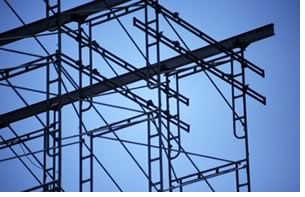

Steel Yourself for Material Shortages Across the Board, Economists Advise
by Douglas E. Gordon, Hon. AIA
It hasn’t been a good year for construction-material buyers. Steel prices have been soaring since October 2003. Portland cement is becoming difficult to purchase at any price. And the high price of oil is causing people to worry about recession again. Economists scheduled to talk at the AIA Convention June 11 say it all has to do with simple supply and demand, except it’s not so simple.
Many fingers point to China, which is experiencing a red-hot 7 to 9 percent growth in its economy. Speculation is that China has its eye on making an eye-opening impression on the world scene when it hosts the summer Olympics in 2008. In the past three years, China has gone from being a net exporter of steel and cement to a net importer. Whether this continues depends on how well China’s leadership can keep the country’s economy on track. Because Chinese decision making is so secretive, economists are generally perplexed about how to predict what will happen next. There seems to be general agreement, though, that the world market in construction materials will remain tight, and that even if China does balance its own production capacity with its domestic demand, India is the next giant waiting in the wings to become a major player in materials consumption.
 But
wait, there’s more
But
wait, there’s more
Ramping up production of the steel, cement, aluminum, copper, coal, and
other materials that China is gobbling up is a time-consuming and costly
matter. Some estimates are that it will take at least three years to catch
up to the projected demand. So it was the speed with which China launched
its construction programs that caught the world market off guard. For
decades, countries, such as the U.S., were taking for granted a relative
materials surplus and, therefore, became dependent on imports to fill
their needs. Until recently, for example, China was exporting its steel
and coal, which added to the worldwide glut. Architects will remember
steel-stud manufacturers recommending their product over wood studs for
residential construction in the late 1990s with the pitch that steel prices
were so much more stable. Then, between 1999 and 2003, with its construction
boom really taking off, China began consuming all of its domestic production
and more—much more.
However, it’s not just underproduction of raw materials that’s to blame for high materials costs. Also at play is the skyrocketing cost of moving bulk materials from mines to mills to consumers. Shipping prices have doubled in a year. Again, much of the problem is the speed at which the worldwide materials shortage developed and the length of time it takes to build the infrastructure to increase supply. As with construction materials, there is currently a three-year backlog in ship building, according to a May 21 Washington Post article. And, because loading and unloading bulk freighters has become a bottleneck, those ships that are available stand idle for weeks at a time waiting to take on their cargo. In a Catch-22 twist, shipyards are having trouble getting the steel to build new ships because there aren’t enough ships to supply them the raw material.
Is there a solution?
China’s economy is growing so rapidly that there is some fear of
a collapse, which would mean a sudden and possibly dramatic drop in materials
prices. But that would probably be bad news, not good, because it could
bring with it a worldwide economic slump. A more hopeful possibility is
that the Chinese slow their growth in the coming months. If they can achieve
a soft landing from their boom rather than an all-out crash, demand will
stay strong as supply is enhanced, and prices will stabilize—probably
about where they are now, maybe a little lower.
The most feasible way to cope with this situation as it develops, then, is to keep yourself informed and maintain strong lines of communication with your clients, consultants, and contractors.
Copyright 2004 The American Institute of Architects.
All rights reserved. Home Page ![]()
![]()
 |
||
| If you’re interested in getting more insight into this situation and how it will be affecting the U.S. construction market for the immediate future, come to the AIA 2004 National Convention for program FR70, Steel Prices: Helping Your Client Cope, June 11, 4–5:30 p.m.
|
||